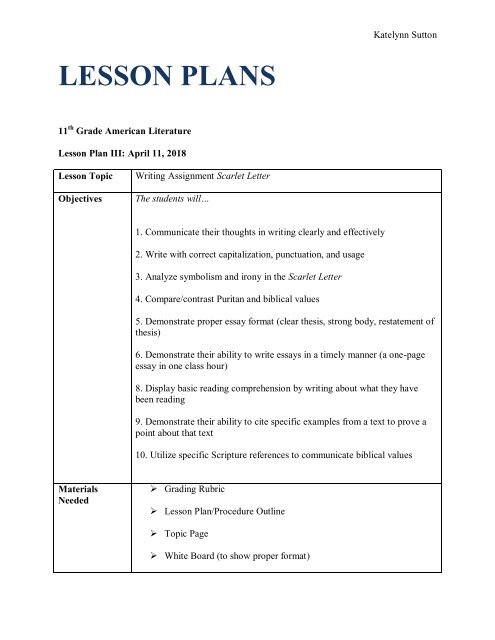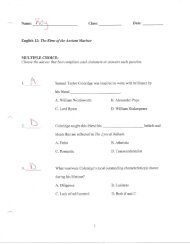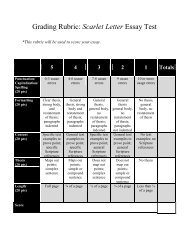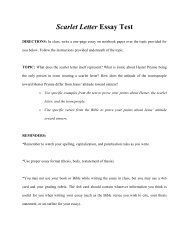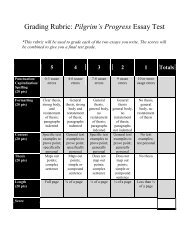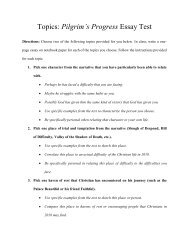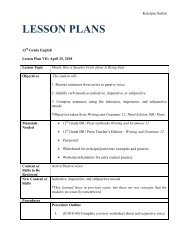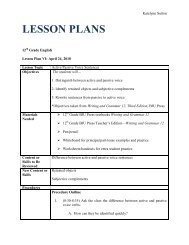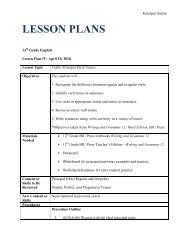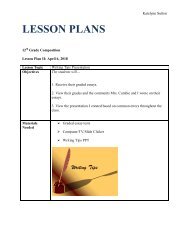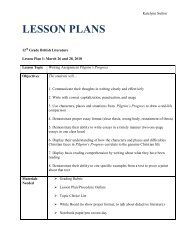19 Scarlet Letter Essay - Lesson Plan PDF
Create successful ePaper yourself
Turn your PDF publications into a flip-book with our unique Google optimized e-Paper software.
Katelynn Sutton<br />
LESSON PLANS<br />
11 th Grade American Literature<br />
<strong>Lesson</strong> <strong>Plan</strong> III: April 11, 2018<br />
<strong>Lesson</strong> Topic<br />
Objectives<br />
Writing Assignment <strong>Scarlet</strong> <strong>Letter</strong><br />
The students will…<br />
1. Communicate their thoughts in writing clearly and effectively<br />
2. Write with correct capitalization, punctuation, and usage<br />
3. Analyze symbolism and irony in the <strong>Scarlet</strong> <strong>Letter</strong><br />
4. Compare/contrast Puritan and biblical values<br />
5. Demonstrate proper essay format (clear thesis, strong body, restatement of<br />
thesis)<br />
6. Demonstrate their ability to write essays in a timely manner (a one-page<br />
essay in one class hour)<br />
8. Display basic reading comprehension by writing about what they have<br />
been reading<br />
9. Demonstrate their ability to cite specific examples from a text to prove a<br />
point about that text<br />
10. Utilize specific Scripture references to communicate biblical values<br />
Materials<br />
Needed<br />
‣ Grading Rubric<br />
‣ <strong>Lesson</strong> <strong>Plan</strong>/Procedure Outline<br />
‣ Topic Page<br />
‣ White Board (to show proper format)
Katelynn Sutton<br />
‣ Notebook paper and pen on test day<br />
‣ Nathaniel Hawthorne PPT<br />
Nathaniel Hawthorne<br />
Symbolism and Irony in The <strong>Scarlet</strong> <strong>Letter</strong><br />
Who was Nathaniel Hawthorne?<br />
• Born in Salem, Massachusetts (1804) into a harsh Puritan ancestry<br />
• Added a “w” to his name<br />
• Lost his father at a young age; raised by wealthy uncles<br />
• Dreamed of becoming a writer after a leg injury as a young child<br />
• Did not enjoy college; secluded himself at home for 12 years, becoming a well-known<br />
short story author<br />
• Met and proposed to Sophia Peabody<br />
• Spent time living in Brook Farm, becoming acquainted with Emerson and Thoreau<br />
• Moved his family around New England, in and out of debt<br />
• Failed at gaining political office<br />
• Wrote his masterpiece, The <strong>Scarlet</strong> <strong>Letter</strong><br />
• Became internationally prominent for his other works<br />
• Declining health stemmed his success as an author in later years; died in 1864<br />
What kind of literature did he write?<br />
Affective – literature to entertain<br />
OR<br />
Didactive – literature to teach<br />
*Good literature teaches and pleases!<br />
What is Nathaniel Hawthorne trying to<br />
communicate through The <strong>Scarlet</strong> <strong>Letter</strong>?<br />
• What does the scarlet letter<br />
symbolize?<br />
• What is ironic about Hester<br />
Prynne being the only person<br />
to wear one?<br />
• How do Puritan values<br />
compare to biblical, Christ-like<br />
values? Are they the same or<br />
different?<br />
Content or<br />
Skills to Be<br />
Reviewed<br />
New Content or<br />
Symbols and irony that students have encountered so far in The <strong>Scarlet</strong><br />
<strong>Letter</strong>.<br />
Comparison of the Puritan values woven into The <strong>Scarlet</strong> <strong>Letter</strong> with biblical
Katelynn Sutton<br />
Skills<br />
Procedures<br />
values.<br />
Procedure Outline<br />
I. (8:30-8:45) Discuss with the class the difference between didactive<br />
and affective literature – The <strong>Scarlet</strong> <strong>Letter</strong> is meant to teach them<br />
something.<br />
A. Who is Nathaniel Hawthorne? (use PPT to teach through his<br />
life)<br />
B. Is his literature produced for entertainment or teaching?<br />
C. What in his past could have triggered the setting and themes<br />
of The <strong>Scarlet</strong> <strong>Letter</strong>?<br />
D. What does the scarlet letter itself symbolize?<br />
E. What is ironic about Hester Prynne being the only<br />
townsperson wearing one?<br />
F. How do Puritan values compare with biblical values?<br />
II.<br />
(8:45-8:55) Pass out the essay test topic/instruction sheet. Read<br />
through the topic with them and explain. Correlate the topic with the<br />
PPT.<br />
A. Be clear about my expectations<br />
B. Correlate the relationship between the didactic <strong>Scarlet</strong> <strong>Letter</strong><br />
to this assignment (they will write what symbolism and irony<br />
they have recognized and compare Puritan values with<br />
biblical values)<br />
III.<br />
(8:55-9:10) Pass out and explain the grading rubric.<br />
A. Students will only be graded over what is on the rubric<br />
B. The rubric, although specific, includes things that should<br />
already be true of their writing level as a junior in high school.<br />
C. Remind them of proper essay formatting<br />
D. Be clear about the thesis statement (should be complex;<br />
should map out their points).
Katelynn Sutton<br />
Key Questions<br />
(1) What do we call literature that is meant to teach, not just please?<br />
(2) What is unique about good literature?<br />
(3) What in Hawthorne’s ancestry could have triggered his setting of The<br />
<strong>Scarlet</strong> <strong>Letter</strong>?<br />
(4) What does the scarlet letter itself represent?<br />
(5) What is ironic about Hester Prynne being the only townsperson with a<br />
scarlet letter?<br />
(6) How do Puritan values compare to biblical, Christ-like values?<br />
Activities<br />
‣ Class discussion<br />
‣ Author analysis<br />
‣ Applying of author’s background to his literature<br />
‣ Comparing of an author’s depictions to the Bible<br />
‣ Assignment explanation<br />
‣ Answering of students’ questions<br />
Summary or Conclusion<br />
Didactive literature is timeless—the authors of didactive literature use<br />
timeless, universal themes. Hawthorne’s themes of overwhelming guilt,<br />
hypocritical refusal to forgive and forget, and self-destructing attempts of<br />
revenge are relatable! Which of us have not ever experienced overwhelming<br />
guilt for our own sin? Which of us has never been either the one<br />
hypocritically withholding forgiveness or so desperately desiring withheld<br />
forgiveness? Which of us has not seen (or experienced) a person destroying<br />
his life in bitterness and heartache when trying to enact revenge on a<br />
wrongdoer? Those are all daily battles and struggles evident in our society<br />
and our lives today. Although Hawthorne does not necessarily provide a<br />
satisfying solution to these terrible sin problems, the Bible does. How can we<br />
resolve these struggles using practical advice from God’s Word?
Katelynn Sutton


